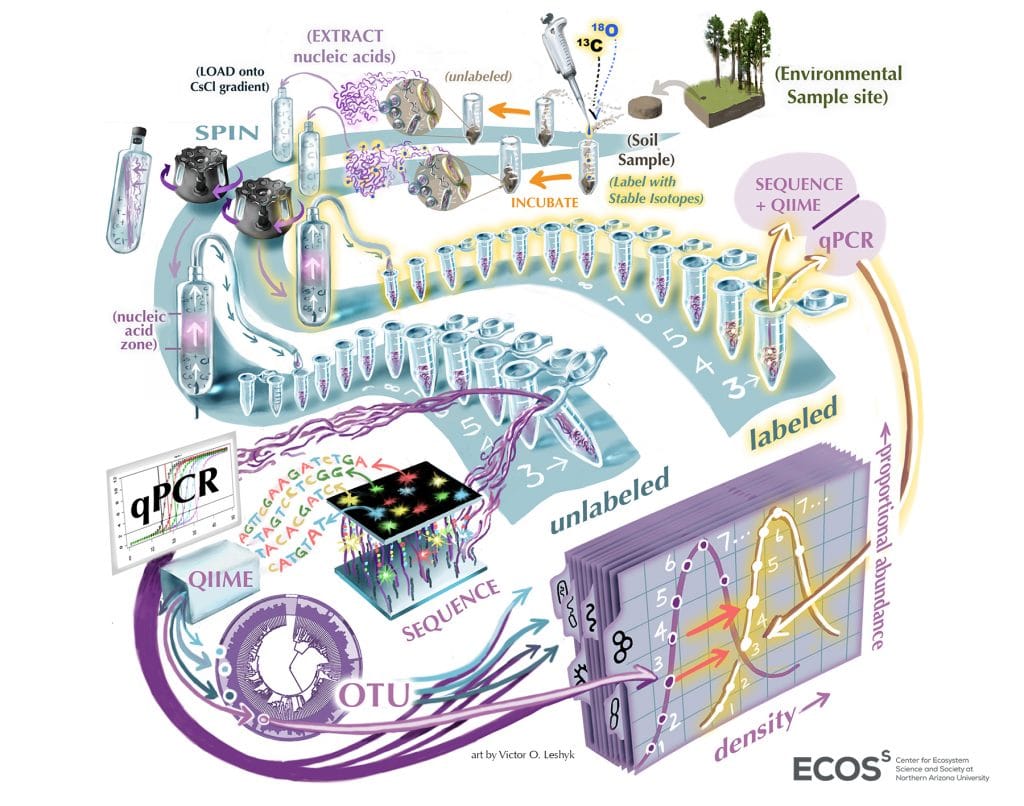If the fate of carbon is a test that planet Earth is taking right now, one of the answer keys is likely to be found in soil, where microorganisms—which account for nearly 15 percent of global biomass, by some estimates—eat, store and respire carbon and other nutrients. As Earth warms, how these microbes change the way they live will have potentially big consequences for where the carbon goes.
Now, a team led by Bruce Hungate of the Center for Ecosystem Science and Society (Ecoss) and researchers at Lawrence Livermore National Laboratory, Pacific Northwest National Laboratory and West Virginia University have received a three-year, $3.3 million grant from the U.S. Department of Energy to investigate how microbes contend with warming. The team, which includes Ecoss professors Michelle Mack, Paul Dijkstra and Egbert Schwartz and research associate Benjamin Koch, will search for clues to this global carbon conundrum in the genomes and transcriptomes of soil bacteria, viruses and fungi.
“The scientific community is really trying to unlock ways to better project the amount of carbon dioxide in the atmosphere, and investigating how diversely microbes use carbon and other nutrients is one key we’re testing,” Hungate said.
To understand a range of ecosystem responses, the team will conduct field and laboratory experiments at established long-term warming sites in four different climatic zones: arctic (Toolik Lake in Alaska), boreal (SPRUCE forest in Minnesota), temperate (Merriam-Powell Climate Change Experiment in Arizona) and tropical (Luquillo Experimental Forest in Puerto Rico). These sites contain soil plots that have been warmed above ambient temperature at different levels for intervals between five and 20 years.
Working with soils from these sites, the team will use techniques including NanoSIMS, quantitative stable isotope probing (qSIP) and Chip-SIP to measure bacterial growth rates, community RNA enrichment and carbon and nitrogen uptake at the level of the cell. These high-resolution methods help illumine the ways a microbe’s evolutionary path influences its response to environmental changes like warming.
Despite the great diversity of bacteria, viruses and other organisms that live in soil, they have, until recently, been sorted and studied into rougher categories using simpler markers. This limited what microbial ecologists could tell about the varied life contained in a gram of soil—somewhat like guessing the contents of a letter when you can only see the postmark and stamp.
“We know that different plant species use soil nutrients is vastly different ways, and, using genomics, we’re seeing that’s true in the microbial realm, too,” Hungate said. “Better understanding how microbes’ genes influence and respond to a warming environment will help us fill in and update what is a rapidly changing global carbon picture. In that way, these experiments act as a periscope: they help us see farther into the future of our planet.”
And it’s a planet experiencing acute climate stress. As wildfires wrack Australia, the world’s oceans are the warmest in recorded history and atmospheric carbon dioxide reached a new high this week—415.79 parts per million recorded on Jan. 21—what is the role of long-term studies like these?
“To predict the interactions and ramifications of the multiple threats we face—warming, limited water, too much and too little of soil nutrients—we need long-term studies that allow us to monitor unforeseen ecosystem adaptations,” said Jennifer Pett-Ridge, a collaborator and lead investigator at Lawrence Livermore National Laboratory. “But if we fool ourselves into waiting to act on climate change until our projects are completed, we will remain hopelessly behind the curve, as ecosystem adaptations outpace our ability to measure and comprehend.”
Photo illustration by Victor O. Leshyk
Kate Petersen | Center for Ecosystem Science and Society
(928) 523-2982 | kate.petersen@nau.edu




